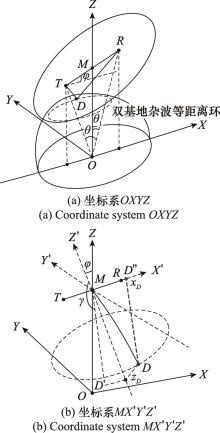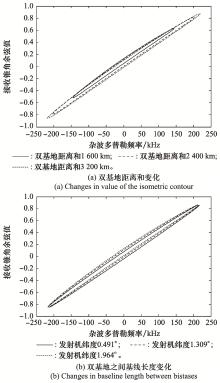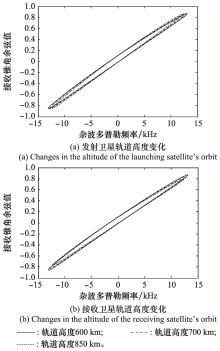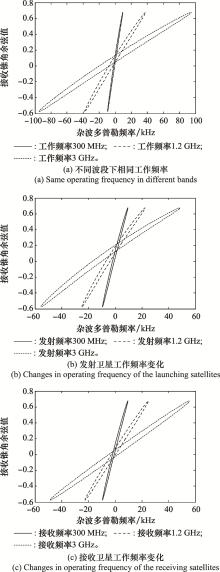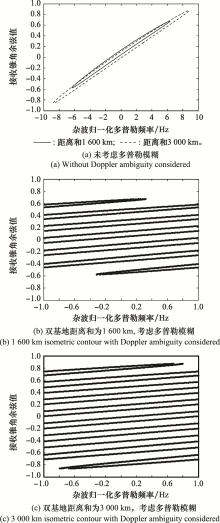Systems Engineering and Electronics ›› 2023, Vol. 45 ›› Issue (4): 1024-1031.doi: 10.12305/j.issn.1001-506X.2023.04.11
• Sensors and Signal Processing • Previous Articles
Clutter modeling and characteristic analysis of spaceborne bistatic radar
Mengyu NI1,*, Hui CHEN1, Xiaoge WANG1, Yang CHENG2, Binbin LI1
- 1. Air Force Early Warning Academy, Wuhan 430019, China
2. Unit 95662 of the PLA, Lhasa 850000, China
-
Received:2021-07-26Online:2023-03-29Published:2023-03-28 -
Contact:Mengyu NI
CLC Number:
Cite this article
Mengyu NI, Hui CHEN, Xiaoge WANG, Yang CHENG, Binbin LI. Clutter modeling and characteristic analysis of spaceborne bistatic radar[J]. Systems Engineering and Electronics, 2023, 45(4): 1024-1031.
share this article
| 1 |
SIKANETA I , GIERULL C H , CERUTTI-MAORI D . Optimum signal processing for multichannel SAR: with application to high-resolution wide-swath imaging[J]. IEEE Trans. on Geoscience and Remote Sensing, 2014, 52 (10): 6095- 6109.
doi: 10.1109/TGRS.2013.2294940 |
| 2 | 邓云凯, 禹卫东, 张衡, 等. 未来星载SAR技术发展趋势[J]. 雷达学报, 2020, 9 (1): 1- 33. |
| DENG Y K , YU W D , ZHANG H , et al. Forthcoming spaceborne SAR development[J]. Journal of Radars, 2020, 9 (1): 1- 33. | |
| 3 |
KIM J H , YOUNIS M , PRATS-IRAOLA P , et al. First spaceborne demonstration of digital beamforming for azimuth ambiguity suppression[J]. IEEE Trans. on Geoscience and Remote Sensing, 2013, 51 (1): 579- 590.
doi: 10.1109/TGRS.2012.2201947 |
| 4 |
ZDING Z G , XIAO F , XIE Y Z , et al. A modified fixed-point chirp scaling algorithm based on updating phase factors regionally for spaceborne SAR real-time imaging[J]. IEEE Trans. on Geoscience and Remote Sensing, 2018, 56 (12): 7436- 7451.
doi: 10.1109/TGRS.2018.2852062 |
| 5 |
HU C , LI Y H , DONG X C , et al. Performance analysis of L-band geosynchronous SAR imaging in the presence of ionospheric scintillation[J]. IEEE Trans. on Geoscience and Remote Sensing, 2017, 55 (1): 159- 172.
doi: 10.1109/TGRS.2016.2602939 |
| 6 |
LI Z F , WANG H Y , SU T , et al. Generation of wide-swath and high-resolution SAR images from multichannel small spaceborne SAR systems[J]. IEEE Geoscience and Remote Sensing Letters, 2005, 2 (1): 82- 86.
doi: 10.1109/LGRS.2004.840610 |
| 7 |
KRIEGER G , GEBERT N , MOREIRA A . Unambiguous SAR signal reconstruction from nonuniform displaced phase center sampling[J]. IEEE Geoscience and Remote Sensing Letters, 2004, 1 (4): 260- 264.
doi: 10.1109/LGRS.2004.832700 |
| 8 |
WANG J G , WANG Y F , ZHANG J M , et al. Resolution calculation and analysis in bistatic SAR with geostationary illuminator[J]. IEEE Geoscience and Remote Sensing Letters, 2013, 10 (1): 194- 198.
doi: 10.1109/LGRS.2012.2197850 |
| 9 |
WU J J , SUN Z C , AN H Y , et al. Azimuth signal multichannel reconstruction and channel configuration design for geosynchronous spaceborne-airborne bistatic SAR[J]. IEEE Trans. on Geoscience and Remote Sensing, 2019, 57 (4): 1861- 1872.
doi: 10.1109/TGRS.2018.2869835 |
| 10 | CUI C, DONG X C, HU C. Performance analysis and configuration design of geosynchronous spaceborne-airborne bistatic moving target indication system[C]//Proc. of the IEEE International Geoscience and Remote Sensing Symposium, 2020. |
| 11 | ZHANG Y H, HIMED B. Effects of geometry on clutter cha-racteristics of bistatic radars[C]//Proc. of the IEEE Radar Conference, 2003: 417-424. |
| 12 | HIMED B, MICHELS J H, ZHANG Y H. Bistatic STAP performance analysis in radar applications[C]//Proc. of the IEEE Radar Conference, 2001: 198-203. |
| 13 |
LONG Y J , ZHAO F J , ZHENG M J , et al. A novel azimuth ambiguity suppression method for spaceborne dual-channel SAR-GMTI[J]. IEEE Geoscience and Remote Sensing Letters, 2021, 18 (1): 87- 91.
doi: 10.1109/LGRS.2020.2967176 |
| 14 |
XU H J , YANG Z W , TIAN M , et al. An extended moving target detection approach for high-resolution multichannel SAR-GMTI systems based on enhanced shadow-aided decision[J]. IEEE Trans. on Geoscience and Remote Sensing, 2018, 56 (2): 715- 729.
doi: 10.1109/TGRS.2017.2754098 |
| 15 | ZHAO Z X , CHEN X , WANG Y H , et al. Range-Doppler spectrograms-based graph-relational mapping for clutter rejection in HF passive radar[J]. IEEE Geoscience and Remote Sensing Letters, 2020, 21 (22): 26006- 26013. |
| 16 |
YAN X Y , CHEN J , NIES H , et al. A bistatic analytical approximation model for Doppler rate estimation error from real-time spaceborne SAR onboard orbit determination data[J]. Remote Sensing, 2020, 12 (19): 3156.
doi: 10.3390/rs12193156 |
| 17 |
ZHANG Y , XIONG W , DONG X C , et al. A novel azimuth spectrum reconstruction and imaging method for moving targets in geosynchronous spaceborne-airborne bistatic multichannel SAR[J]. IEEE Trans. on Geoscience and Remote Sensing, 2020, 58 (8): 5976- 5991.
doi: 10.1109/TGRS.2020.2974531 |
| 18 | MELVN W L, HIMED B, DAVIS M. Doubly adaptive bistatic clutter filtering[C]//Proc. of the IEEE Radar Conference, 2003: 171-178. |
| 19 | CHIN H, LIM B, ABOUTANIOS E, et al. Modified JDL with Doppler compensation for airborne bistatic radar[C]//Proc. of the IEEE International Radar Conference, 2005: 854-858. |
| 20 |
ZHANG S X , XING M D , ZONG Y L . A novel weighted Doppler centroid estimation approach based on electromagnetic scattering model for multichannel in azimuth HRWS SAR system[J]. IEEE Trans. on Geoscience and Remote Sensing, 2018, 56 (9): 5015- 5034.
doi: 10.1109/TGRS.2018.2804334 |
| 21 |
VARADARAJAN V , KROLIK J L . Joint space-time interpolation for distorted linear and bistatic array geometries[J]. IEEE Trans. on Signal Processing, 2006, 54 (3): 848- 860.
doi: 10.1109/TSP.2005.862941 |
| 22 | 张双喜, 乔宁, 邢孟道, 等. 多普勒频谱模糊情况下的星载方位向多通道高分宽幅SAR-GMTI杂波抑制方法[J]. 雷达学报, 2020, 9 (2): 295- 303. |
| ZHANG S X , QIAO N , XING M D , et al. A novel clutter suppression approach for the space-borne multiple channel in the azimuth high-resolution and wide-swath SAR-GMTI system with an ambiguous Doppler spectrum[J]. Journal of Radars, 2020, 9 (2): 295- 303. | |
| 23 |
ZHANG S X , XING M D , XIA X G , et al. Robust clutter suppression and moving target imaging approach for multichannel in azimuth high-resolution and wide-swath synthetic aperture radar[J]. IEEE Trans. on Geoscience and Remote Sensing, 2015, 53 (2): 687- 709.
doi: 10.1109/TGRS.2014.2327031 |
| 24 | 田明明, 廖桂生, 李云鹏, 等. 超高速平台载雷达杂波特性与抑制方法[J]. 系统工程与电技术, 2020, 42 (2): 301- 308. |
| TIAN M M , LIAO G S , LI Y P , et al. Clutter properties and suppression method of hypersonic platform radar[J]. Systems Engineering and Electronics, 2020, 42 (2): 301- 308. | |
| 25 |
KLEMM R . Comparison between monostatic and bistatic antenna configurations for STAP[J]. IEEE Trans. on Aerospace and Electronic Systems, 2000, 36 (2): 596- 608.
doi: 10.1109/7.845248 |
| 26 | DUAN R , WANG X G , JIANG C S , et al. Space-time clutter model for airborne bistatic radar with non-Gaussian statistics[J]. Journal of Systems Engineering and Electronics, 2009, 20 (2): 283- 290. |
| 27 |
PILLAI S U , HIMED B , LI K Y . Effect of Earth's rotation and range fold over on space-based radar performance[J]. IEEE Trans. on Aerospace and Electronic Systems, 2006, 42 (3): 917- 932.
doi: 10.1109/TAES.2006.248188 |
| 28 | ZULCH P, DAVIS M, ADZIMA L, et al. The earth rotation effect on a LEO L-band GMTI SBR and mitigation strategies[C]//Proc. of the IEEE Radar Conference, 2004: 27-32. |
| 29 | 刘楠, 张林让, 易予生, 等. 星载双基地雷达空时二维杂波建模和特性分析[J]. 西安电子科技大学学报(自然科学版), 2009, 36 (3): 390- 395. |
| LIU N , ZHANG L R , YI Y S , et al. Clutter modeling and analysis for spaceborne bistatic radar[J]. Journal of Xidian University (Natural Science), 2009, 36 (3): 390- 395. | |
| 30 | 李华, 汤俊, 彭应宁. 星载双基地雷达空时二维杂波建模方法[J]. 电子学报, 2008, 36 (3): 417- 420. |
| LI H , TANG J , PENG Y N . Modeling of space-time clutter for bistatic space based radar[J]. Acta Electronica Sinica, 2008, 36 (3): 417- 420. |
| [1] | Hanyi HUANG, Shiyou HU, Shenglong GUO, Shanjun LI, Qin SHU. Sea surface micro-moving target recognition based on sparse decomposition [J]. Systems Engineering and Electronics, 2023, 45(4): 1016-1023. |
| [2] | An'an WANG, Wenchong XIE, Wei CHEN, Yuanyi XIONG, Yongliang WANG. Clutter and main-lobe suppression jamming suppression method for bistatic airborne radar [J]. Systems Engineering and Electronics, 2023, 45(3): 699-707. |
| [3] | Junling ZHANG, Mei DONG, Baixiao CHEN. Sea clutter suppression algorithm based on tunable Q-factor wavelet transform [J]. Systems Engineering and Electronics, 2023, 45(2): 343-351. |
| [4] | Cheng CHEN, Tao LIU, Laibao CAO, Zhihua HE, Chunlin HUANG, Yi SU. Uneven surface clutter mitigation for holographic subsurface radar [J]. Systems Engineering and Electronics, 2022, 44(9): 2776-2782. |
| [5] | Liru YANG, Yongxiang LIU, Wei YANG. Radar clutter amplitude statistical model selection based on transfer learning [J]. Systems Engineering and Electronics, 2022, 44(8): 2457-2467. |
| [6] | Yuzhuo WANG, Shengqi ZHU, Ximin LI, Lan LAN. Range ambiguous clutter suppression for FDA MIMO bistatic radar with main lobe correction [J]. Systems Engineering and Electronics, 2022, 44(5): 1483-1494. |
| [7] | Wenjing LI, Zhuolin LI, Zhentao YUAN. Sea clutter suppression and target extraction algorithm based on sparse reconstruction [J]. Systems Engineering and Electronics, 2022, 44(3): 777-785. |
| [8] | Mingze WANG, Wei LI, Junwei MA, Xiangping LI. Clutter suppression algorithm based on pixel vector elimination in through-the-wall radar [J]. Systems Engineering and Electronics, 2022, 44(3): 827-833. |
| [9] | Pengyuan HE, Zhiwei YANG, Xiao TAN. Performance analysis and configuration optimization of clutter repection ability of spaceborne bistatic radar [J]. Systems Engineering and Electronics, 2022, 44(2): 440-447. |
| [10] | Yanling SHI, Lei WANG, Junhao LI. CFAR detection for small targets on sea surface based on singular value decomposition in projection space [J]. Systems Engineering and Electronics, 2022, 44(2): 512-519. |
| [11] | Chunling XUE, Fei CAO, Qing SUN, Jianqiang QIN, Xiaowei FENG. Sea-surface weak target detection based on multi-feature information fusion [J]. Systems Engineering and Electronics, 2022, 44(11): 3338-3345. |
| [12] | Hai LI, Ze HUYAN, Zhijie MAO. Low-altitude wind-shear velocity ambiguity resolution based on compressed sensing under strong clutter [J]. Systems Engineering and Electronics, 2022, 44(10): 3029-3036. |
| [13] | Xiaojiao PANG, Yongbo ZHAO, Chenghu CAO, Yili HU, Sheng CHEN. Reduced-dimension space-time adaptive processing method based on the covariance fitting criterion [J]. Systems Engineering and Electronics, 2022, 44(1): 86-93. |
| [14] | Ruiyang LI, Weibo HUO, Wei MA, Ziyang CHENG. Covariance matrix estimation method based on inverse Gaussian texture distribution [J]. Systems Engineering and Electronics, 2021, 43(9): 2470-2475. |
| [15] | Jiayi ZHANG, Zhongyang YU, Min ZHU, Baoming BAI, Wei LIU, Qilong RONG. Design of carrier synchronization algorithm for SCMA system in LEO satellite communication [J]. Systems Engineering and Electronics, 2021, 43(5): 1354-1360. |
| Viewed | ||||||
|
Full text |
|
|||||
|
Abstract |
|
|||||
